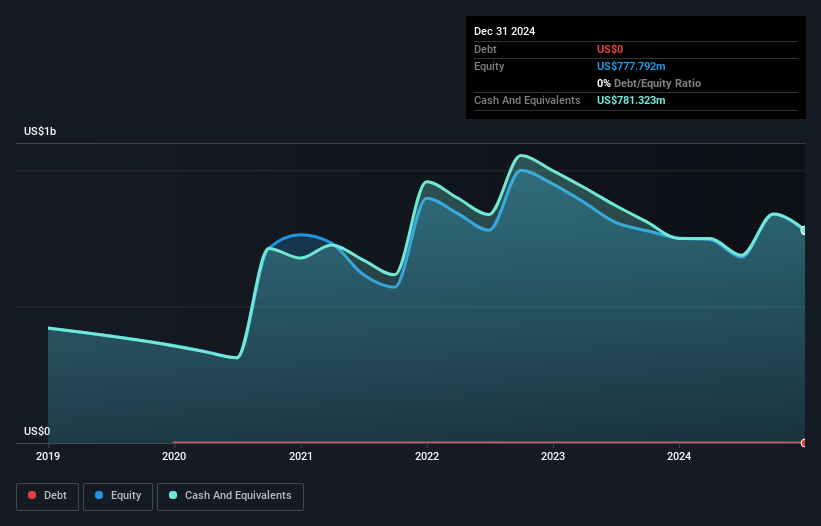- United States
- /
- Biotech
- /
- NasdaqGM:RLAY
Here's Why We're Watching Relay Therapeutics' (NASDAQ:RLAY) Cash Burn Situation
Just because a business does not make any money, does not mean that the stock will go down. For example, although software-as-a-service business Salesforce.com lost money for years while it grew recurring revenue, if you held shares since 2005, you'd have done very well indeed. But while history lauds those rare successes, those that fail are often forgotten; who remembers Pets.com?
Given this risk, we thought we'd take a look at whether Relay Therapeutics (NASDAQ:RLAY) shareholders should be worried about its cash burn. In this article, we define cash burn as its annual (negative) free cash flow, which is the amount of money a company spends each year to fund its growth. First, we'll determine its cash runway by comparing its cash burn with its cash reserves.
How Long Is Relay Therapeutics' Cash Runway?
A company's cash runway is calculated by dividing its cash hoard by its cash burn. When Relay Therapeutics last reported its December 2024 balance sheet in February 2025, it had zero debt and cash worth US$781m. In the last year, its cash burn was US$251m. That means it had a cash runway of about 3.1 years as of December 2024. A runway of this length affords the company the time and space it needs to develop the business. You can see how its cash balance has changed over time in the image below.

See our latest analysis for Relay Therapeutics
How Well Is Relay Therapeutics Growing?
On balance, we think it's mildly positive that Relay Therapeutics trimmed its cash burn by 18% over the last twelve months. But it makes us pessimistic to see that operating revenue slid 61% in that time. Taken together, we think these growth metrics are a little worrying. Clearly, however, the crucial factor is whether the company will grow its business going forward. So you might want to take a peek at how much the company is expected to grow in the next few years .
How Hard Would It Be For Relay Therapeutics To Raise More Cash For Growth?
Relay Therapeutics seems to be in a fairly good position, in terms of cash burn, but we still think it's worthwhile considering how easily it could raise more money if it wanted to. Issuing new shares, or taking on debt, are the most common ways for a listed company to raise more money for its business. Many companies end up issuing new shares to fund future growth. By looking at a company's cash burn relative to its market capitalisation, we gain insight on how much shareholders would be diluted if the company needed to raise enough cash to cover another year's cash burn.
Since it has a market capitalisation of US$376m, Relay Therapeutics' US$251m in cash burn equates to about 67% of its market value. Given how large that cash burn is, relative to the market value of the entire company, we'd consider it to be a high risk stock, with the real possibility of extreme dilution.
Is Relay Therapeutics' Cash Burn A Worry?
On this analysis of Relay Therapeutics' cash burn, we think its cash runway was reassuring, while its cash burn relative to its market cap has us a bit worried. Summing up, we think the Relay Therapeutics' cash burn is a risk, based on the factors we mentioned in this article. An in-depth examination of risks revealed 4 warning signs for Relay Therapeutics that readers should think about before committing capital to this stock.
Of course, you might find a fantastic investment by looking elsewhere. So take a peek at this free list of interesting companies, and this list of stocks growth stocks (according to analyst forecasts)
New: AI Stock Screener & Alerts
Our new AI Stock Screener scans the market every day to uncover opportunities.
• Dividend Powerhouses (3%+ Yield)
• Undervalued Small Caps with Insider Buying
• High growth Tech and AI Companies
Or build your own from over 50 metrics.
Have feedback on this article? Concerned about the content? Get in touch with us directly. Alternatively, email editorial-team (at) simplywallst.com.
This article by Simply Wall St is general in nature. We provide commentary based on historical data and analyst forecasts only using an unbiased methodology and our articles are not intended to be financial advice. It does not constitute a recommendation to buy or sell any stock, and does not take account of your objectives, or your financial situation. We aim to bring you long-term focused analysis driven by fundamental data. Note that our analysis may not factor in the latest price-sensitive company announcements or qualitative material. Simply Wall St has no position in any stocks mentioned.
About NasdaqGM:RLAY
Relay Therapeutics
Operates as a clinical-stage precision medicines company.
Flawless balance sheet with low risk.
Market Insights
Community Narratives





